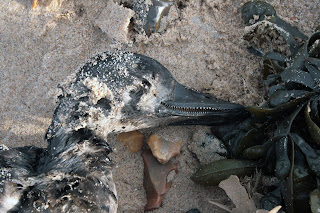I found out recently that my old friend Dennis Brooker died just before Christmas, a couple of months short of his 96th birthday. I first met Den 34 years ago back in 1984, when I was an impressionable 19 year old volunteer on Operation Osprey and Den was in his early 60's.
At that time the Osprey camp was still run on the model set up by
George Waterson and Frank Hamilton, volunteers slept in tents and used chemical toilets. The rota was based on teams of three taking turns to guard the nest, talk to the public and do the chores around the Osprey camp and perhaps more importantly to a reasonably obsessive young birdwatcher every three days you got 24 hours off to do with as you wished. If you were lucky and had a car owner in your team this could mean birding excursions all over the Highlands.
 |
| Den Brooker outside the Osprey Hide 1984 |
During that first hot summer on the Ospreys I must have found myself on Den's team and I recall his easy going company, thoughtful speech and a twinkle in his eye when it came to the ladies. He was to my young mind charismatic and a bit of a unconventional role model. A social sort of a chap he was often to be found in the kitchen sipping a glass of red wine whilst helping the invariably young female cook.
Plants were Den's passion and I must have agreed to go looking for Bog Orchid's with him one day, I think I negotiated a promise out of him that we would go birding on the coast afterwards. Something which he graciously agreed to. Many years after he sent me a printed booklet of short essays his
"fragments of a personal flora" I got it down the other day and re-read the account of our excursion. I had to laugh as I read his short pen portrait of me.
"So one Sunday morning S and I set forth to Inverness. S was large, ginger haired, loquacious even in his sleep (we shared a bell tent), later served as Information Warden, and at that time was profoundly uninterested in plants." Funny I have some vivid memories of that particular day out looking for what I uncharitably described as "Bogey's on a stick" After our successful botanising we headed to the coast at Burgh Head a austere Moray Coast fishing village. I vividly remember sitting on the slope of a hill overlooking the sea whilst a male Kestrel hovered for ages at eye level, then a pod of sleek battleship grey Bottle Nose Dolphins swam past close inshore, my first dolphins and I later put an elderly passer by right when he tried to tell me that they were porpoises.
Den will have been known to a large number of RSPB seasonal staff and volunteers who worked at the Osprey camp in the 80's. I wear as a badge of pride the fact that he used to refer to me along with Richard Thaxton who went onto be the RSPB Site Manager at Abernethy and Zul Bhatia who was RSPB Site Manager at Insh Marshes and then Lochwinnoch as his "young men". The passage of time means that Richard and Zul have both now retired from the RSPB, I the baby of the trio have a fair few years ahead of me yet before I stop work.
In recent years I saw little of Den but would look forward to his homemade Christmas cards usually an abstract photo of a plant accompanied by his almost indecipherable scrawl. Sometimes we'd talk on the phone and he'd tell me about his latest visit to Kew Gardens, his curiosity and lust for life still strong in his early 90's. the last call was difficult as his hearing had gone. My spell working at Titchwell coincided with Den's girlfriend being a retired lady doctor based in Cambridge and would look forward to occasionally bumping into him on the West Bank path. I still use in public talks that I give about the Norfolk Coast something he said to me on one occasion at Titchwell. "The great thing about Titchwell is that you can walk amongst the birds" A great summation of a fine place and perhaps also of Den's life
walking amongst the birds.
 |
| Goldeneye, Loch Mallachie, Abernethy Forest |




































